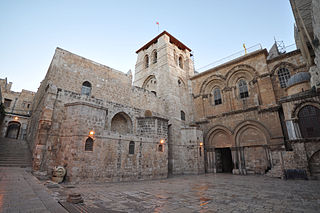Church of the Holy Sepulchre │ Tomb of Jesus Christ │Calvery
The Church of the Holy Sepulchre, also called the Church of the Resurrection or Church of the Anastasis by Orthodox Christians) is a church in the Christian Quarter of the Old City of Jerusalem, a few steps away from the Muristan. The church contains, according to traditions dating back to at least the fourth century, the two holiest sites in Christianity: the site where Jesus of Nazareth was circumcised, presented in the temple, where he drove out the money changers, and was crucified, at a place known as “Calvary” or “Golgotha”, and Jesus’s empty tomb, where he is said to have been buried and resurrected. The tomb is enclosed by the 18th-century shrine, called the Aedicule (Edicule).
Within the church proper are the last four (or, by some definitions, five) Stations of the Via Dolorosa, representing the final episodes of Jesus’ Passion. The church has been a major Christian pilgrimage destination since its creation in the fourth century, as the traditional site of the Resurrection of Christ, thus its original Greek name, Church of the Anastasis.
Today, the wider complex accumulated during the centuries around the Church of the Holy Sepulchre also serves as the headquarters of the Greek Orthodox Patriarch of Jerusalem, while control of the church itself is shared between several Christian denominations and secular entities in complicated arrangements essentially unchanged for over 160 years, and some for much longer. The main denominations sharing property over parts of the church are the Greek Orthodox, Armenian Orthodox and Roman Catholic, and to a lesser degree the Egyptian Copts, Syriacs and Ethiopians. Meanwhile, Protestants, including Anglicans, have no permanent presence in the Church and they generally prefer The Garden Tomb, elsewhere in Jerusalem, as either the true place of Jesus’ crucifixion and resurrection, or at least a more evocative site to commemorate those events.
Calvary (Golgotha)

On the south side of the altar, via the ambulatory, is a stairway climbing to Calvary (Golgotha), traditionally regarded as the site of Jesus’ crucifixion and the most lavishly decorated part of the church. The main altar there belongs to the Greek Orthodox, which contains the Rock of Calvary (12th Station of the Cross). The rock can be seen under glass on both sides of the altar, and beneath the altar there is a hole said to be the place where the cross was raised. Due to the significance of this, it is the most visited site in the Church of the Holy Sepulchre. The Roman Catholics (Franciscans) have an altar to the side, the Chapel of the Nailing of the Cross (11th Station of the Cross). On the left of the altar, towards the Eastern Orthodox chapel, there is a statue of Mary, believed by some to be miraculous (the 13th Station of the Cross, where Jesus’ body was removed from the cross and given to his family).[citation needed]
Beneath the Calvary and the two chapels there, on the main floor, there is the Chapel of Adam. According to tradition, Jesus was crucified over the place where Adam’s skull was buried. According to some, at the crucifixion, the blood of Christ ran down the cross and through the rocks to fill the skull of Adam. The Rock of Calvary appears cracked through a window on the altar wall, with the crack traditionally claimed to be caused by the earthquake that occurred when Jesus died on the cross, while some scholars claim it to be the result of quarrying against a natural flaw in the rock.
Stone of Anointing

Just inside the entrance to the church is the Stone of Anointing (also Stone of the Anointing or Stone of Unction), which tradition believes to be the spot where Jesus’ body was prepared for burial by Joseph of Arimathea. However, this tradition is only attested since the crusader era (notably by the Italian Dominican pilgrim Riccoldo da Monte di Croce in 1288), and the present stone was only added in the 1810 reconstruction.
The wall behind the stone is defined by its striking blue balconies and tau cross-bearing red banners (depicting the insignia of the Brotherhood of the Holy Sepulchre), and is decorated with lamps. The modern mosaic along the wall depicts the anointing of Jesus’ body.
Rotunda and Aedicule

The Rotunda is located in the centre of the Anastasis, beneath the larger of the church’s two domes. In the center of the Rotunda is the chapel called the Aedicule, which contains the Holy Sepulchre itself. The Aedicule has two rooms, the first holding the Angel’s Stone, which is believed to be a fragment of the large stone that sealed the tomb; the second is the tomb itself. Possibly due to the fact that pilgrims laid their hands on the tomb and/or to prevent eager pilgrims from removing bits of the original rock as souvenirs, a marble plaque was placed in the fourteenth century on the tomb to prevent further damage to the tomb.
Source : wikipedia
https://www.youtube.com/watch?v=QyvavfIGyLs
https://www.youtube.com/watch?v=Apu7I4AuxI4
https://www.youtube.com/watch?v=Nxi-FWzAzyI
https://www.youtube.com/watch?v=nkmx_k9wVs0
https://www.youtube.com/watch?v=4N39r7bTezg
Reviews
https://goo.gl/l4b7ah



Rate this article